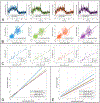Measurement of Frontal Midline Theta Oscillations using OPM-MEG
- PMID: 36918138
- PMCID: PMC10465234
- DOI: 10.1016/j.neuroimage.2023.120024
Measurement of Frontal Midline Theta Oscillations using OPM-MEG
Abstract
Optically pumped magnetometers (OPMs) are an emerging lightweight and compact sensor that can measure magnetic fields generated by the human brain. OPMs enable construction of wearable magnetoencephalography (MEG) systems, which offer advantages over conventional instrumentation. However, when trying to measure signals at low frequency, higher levels of inherent sensor noise, magnetic interference and movement artefact introduce a significant challenge. Accurate characterisation of low frequency brain signals is important for neuroscientific, clinical, and paediatric MEG applications and consequently, demonstrating the viability of OPMs in this area is critical. Here, we undertake measurement of theta band (4-8 Hz) neural oscillations and contrast a newly developed 174 channel triaxial wearable OPM-MEG system with conventional (cryogenic-MEG) instrumentation. Our results show that visual steady state responses at 4 Hz, 6 Hz and 8 Hz can be recorded using OPM-MEG with a signal-to-noise ratio (SNR) that is not significantly different to conventional MEG. Moreover, we measure frontal midline theta oscillations during a 2-back working memory task, again demonstrating comparable SNR for both systems. We show that individual differences in both the amplitude and spatial signature of induced frontal-midline theta responses are maintained across systems. Finally, we show that our OPM-MEG results could not have been achieved without a triaxial sensor array, or the use of postprocessing techniques. Our results demonstrate the viability of OPMs for characterising theta oscillations and add weight to the argument that OPMs can replace cryogenic sensors as the fundamental building block of MEG systems.
Keywords: Low frequency; Magnetoencephalography; Neural oscillations; Optically pumped magnetometers; Theta oscillations; Working memory.
Copyright © 2023. Published by Elsevier Inc.
Conflict of interest statement
Conflicts of interest V.S. is the founding director of QuSpin, a commercial entity selling OPM magnetometers. J.O. and C.D. are employees of QuSpin. E.B. and M.J.B. are directors of Cerca Magnetics Limited, a spin-out company whose aim is to commercialise aspects of OPM-MEG technology. E.B., M.J.B., R.B., N.H. and R.H. hold founding equity in Cerca Magnetics Limited.
Figures







References
-
- Baillet S, 2017. Magnetoencephalography for brain electrophysiology and imaging. Nat. Neurosci 20, 327–339. - PubMed
Publication types
MeSH terms
Grants and funding
LinkOut - more resources
Full Text Sources

